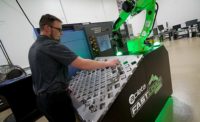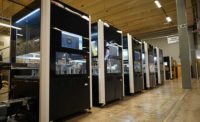Preconfigured Robotic Assembly Cells Cut Costs and Speed Deployment
Ready-to-go systems are becoming increasingly popular.










Standardization is a key concept behind lean manufacturing. It allows assemblers to reduce variation, increase consistency, cut costs and improve productivity by following a prescribed set of work instructions.
The robotics industry has latched onto that basic idea by marketing preconfigured and pre-engineered workcells for welding, dispensing, machine tending and other applications. The cells promise assemblers dramatic savings in cost and deployment time. As a result, the ready-to-go systems are popular with both small job shops and Tier 1 automotive suppliers.
With a preconfigured workcell, all engineering needed to fabricate, assemble and integrate the system is completed before a manufacturer places an order, which significantly shortens delivery time. The cells use common components to reduce engineering and manufacturing costs.
Robot suppliers and systems integrators use the terms “preconfigured” and “pre-engineered” interchangeably. “We define ‘preconfigured’ as a process robot with a part positioner and safeguarding,” says Chris Anderson, welding product marketing manager for the Motoman Robotics division of Yaskawa America Inc. “It is generally ready to weld, with the addition of part fixtures and tooling.”
Chuck Boyer, marketing coordinator at Wolf Robotics LLC, a systems integrator that specializes in welding and cutting applications, defines “pre-engineered” as “cells that provide all the components required for the basic functions of a welding operation.
“They are packaged in a way to allow components to be interchanged with minimal effort, [especially] physical assemblies, electrical connections and software interfaces,” adds Boyer. “By having standardized modules that require no further engineering efforts to configure, they provide lower overhead and pricing advantages that keep costs low, which can be passed on to the consumer.”
“The self-contained turnkey operation typically includes a workstation and fixturing,” notes Nick Hunt, manager of robot technology and support at ABB Robotics. “A servo-controlled axis, operator interface and all safeguarding, such as fencing and light curtains, is included.” For a welding application, this includes a torch. The only customized part of a preconfigured cell is the type of welding power supply that an end user specifies, such as Miller Electric or Lincoln Electric.
“We deliver our preconfigured cells on a superstructure base that can be lifted and delivered in one swoop,” says Hunt. “All you have to do is lift the cell up with a forklift. Wherever you plop it down is where it lives on the plant floor. Nothing needs to be installed or mounted once it arrives at the customer’s location.
“You just power up the robot, because it’s plug-and-play,” adds Hunt. “We provide all the application software, in addition to all sensing mechanisms. The customer only has to supply consumables, such as welding wire, before they’re ready to start welding parts.”
Numerous Advantages
Preconfigured robots typically can be used “right out of the box,” which is a big advantage for manufacturers with limited engineering staffs. “Once you get power to it, this type of configuration is easier than setting up a toy on Christmas day,” claims Anderson. “All you have to do is add your parts and get going.”
“Preconfigured cells have already been designed with ergonomics and aesthetics in mind to provide the most efficient operating system available for the money,” adds Boyer. “They are compact in nature to simplify shipment and setup; minimize factory floor space; provide a quicker delivery time from order to receipt of goods; and utilize standard components for easy replacement and service.”
One big advantage is improved documentation, including parts and schematics. “This aids suppliers in building cells and helps customers maintain the cell,” says Anderson. “Everyone has detailed documentation that’s consistent from cell to cell.”
Another advantage is shorter lead time. Pre-engineered cells use parts that are already sourced and in-stock. “Typically, customers must wait 12 to 14 weeks to get a robot,” Anderson points out. “Customized specifications, such as different types of safeguarding, can push that time frame out to 18 to 20 weeks. With preconfigured cells, we cut that down to eight weeks.”
Quicker start-up time also appeals to engineers. Programs for basic cell operation are typically included; just part-specific programs need to be added. “The customer does not have to design a workcell layout or figure out how to run wires,” says Anderson. “We use quick-connects on cables, so they just plug in and twist lock. Everything is designed to go together quickly.”
Above all else, preconfigured cells offer financial incentives. “Bundles are more cost-effective than a la carte robotic systems,” says Chris Blanchette, national account manager for distribution sales at Fanuc Robotics America Corp. “There’s much higher value than if all the components were purchased separately. We believe this is the wave of the future.
“There are a number of reasons you should consider going this route,” adds Blanchette. “The components are well-integrated, because things were designed in by the source. Everything is well-integrated, as opposed to having multiple companies involved in the process.
“In addition, all components are tested prior to shipment,” says ABB’s Hunt. “As a result, there’s no debug time when the cell arrives. Everything ships debugged, tested and ready to go.
“There’s lower overall cost, because there are fewer layers and margin add-ons associated with using multiple component suppliers,” Hunt points out. “The warranty is carried by only one company, so there are no arguments. If you have a cell with multiple component sources, there can be issues surrounding who will take ownership if a problem arises. In the short run, you’re going to pay less with a preconfigured cell.”
The only big drawback to preconfigured cells is that the size of parts to be assembled is restricted to the size of the system. “If parts are physically larger or heavier than the cell capacity, the system will not be able to accommodate them,” warns Wolf Robotics’ Boyer.
“Unique part size or plant engineering requirements may not be addressed by a common preconfigured workcell,” adds Yaskawa Motoman’s Anderson. “However, components from a preconfigured cell can often be combined in a custom solution to reduce the cost and delivery of a specialized workcell.”
Diverse Applications
Job shops and small manufacturers that have traditionally shied away from using robots are fond of the preconfigured cell concept, which is designed to make robots less intimidating and easier to use.
“Pre-engineered cells are popular with small companies that don’t necessarily have the internal skills, resources and expertise to spec a safety system, write software and design a human-machine interface,” says Hunt.
“Small job shops that have a wide range of customers have success in using these cells due to the ability to easily switch between jobs and part requirements,” adds Boyer. “They typically need to produce a consistent quality product and are experiencing difficulties in finding qualified welding personnel.”
However, Tier 1 suppliers also like the advantages of preconfigured cells. For instance, some automotive seat manufacturers use self-contained cells for spot welding applications. Even some OEMs use the ready-to-go concept for off-line subassembly.
“Any time you use a cookie-cutter cell, that’s where it pays off, because you don’t have to re-engineer everything,” explains Hunt. “Even though automotive suppliers often have the necessary technical talent on the plant floor, the opportunity to buy a complete cell is very appealing to them.”
Some systems integrators are also attracted to preconfigured workcells. “It saves them time,” says Anderson. “They can concentrate their energies on making custom tools for their customers instead of spending their time sourcing safety equipment and other things.”
Welding tends to be the most popular application for preconfigured cells. “It’s an easier process to adapt,” says Boyer. “Weldments can be manufactured with tolerances that allow for precise positioning and fixtures can be designed as simple or complex as required to hold parts in place. Interchanging of tooling is simple and allows the workcell to adapt to numerous components for a quick return on investment.”
“Arc welding is still the most common application for preconfigured cells,” adds Michael Sharpe, staff engineer for materials joining at Fanuc Robotics. “However, we’re starting to see more demand for other assembly applications, such as spot welding, dispensing and sealing, in addition to machine tending.” Cutting, grinding, washing and other machining applications are also popular.
Preconfigured robotic cells are not new. They have been around for more than 10 years. But, the concept has recently evolved to meet changing market demands.
“We now encapsulate more than we did before, because our concept of what a ‘cell’ is has changed over the years.” says Hunt. “In the past, we often used the word ‘system,’ which was considered to be anything other than just a naked robot. We now supply more content with the cells than we did in the past.”
For instance, ABB markets FlexArc robotic arc welding cells that feature either one or two six-axis robots. “It’s a new generation of standardized welding cells that are designed to deliver cost-effective, state-of-the-art robotic operations,” Hunt points out. “All equipment is installed on a common platform, which provides shorter commissioning time and relocation within production facilities.”
Earlier this year, Yaskawa Motoman launched a new program for preconfigured workcells dubbed Quick Ship. Several robotic configurations are available, incorporating the company’s popular ArcWorld and FabWorld cells.
“The Quick Ship program involves our five most popular workcells with defined equipment configurations similar to an automaker’s ‘sport package,’” says Anderson. “It was in response to the increased demand for arc welding robots in the last two years.”
Wolf Robotics calls its preconfigured line WolfPack. The typical cell contains a robot, a positioner, a welding power source, an air-cooled torch apparatus, safety fencing, light curtains and a graphical operation interface on the robot’s teach pendant.
“The WolfPack configurations have been on the market for just over a year now and are starting to become popular,” says Boyer.
Looking for a reprint of this article?
From high-res PDFs to custom plaques, order your copy today!











